|
Visit of a Belgian Missionary to Japan in the Early 17th Century (No.10)
March 4, 2013
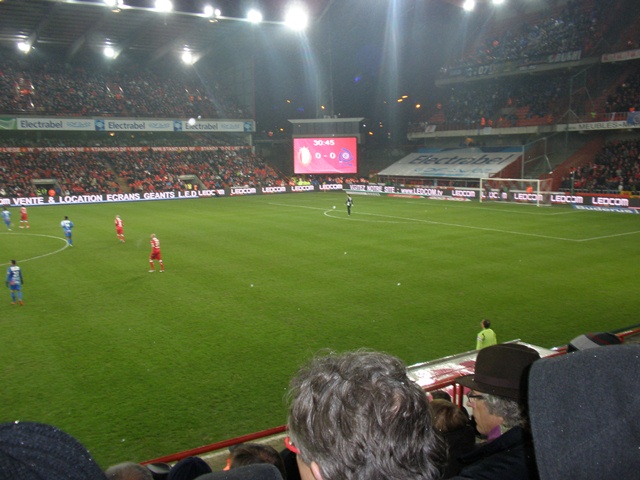 Last weekend, I was invited by the Belgian football team Standard de Liège to watch an official game. For the first time since my arrival I watched a professional game while snow was lightly falling down in the cold. The opponent was KRC Genk, the team of the second largest city in Limburg (65.000 inhabitants) which is located 50 km north of Liège. There are three Japanese players in Standard (see Ambassador’s Chat No 8), but only the goalkeeper Kawashima participated in the game that night. The match greatly attracted attention because it was a confrontation between the third and fourth ranked teams in the first division. However, the result was a draw (0-0) and the home-playing team Standard was very disappointed. Though Chairman Roland Duchatelet sitting next to me, is usually such a quiet person, he sometimes shouted out “Go, Attack!”. The disappointing result was due to the fact that Standard’s play was offensive from the beginning to end. Nevertheless, the enthusiasm of the football fans was remarkable. Despite the cold weather that day, the Sclessin Stadium, which can accommodate 30,000 people, was jam-packed. Even from before the game had started the fans made a great tumult setting off firecrackers. My car was stuck for more than 30 minutes after the game, surrounded by a crowd of fans. It was late at night when I got home in Brussels. Dear me, watching football is not that easy. Last weekend, I was invited by the Belgian football team Standard de Liège to watch an official game. For the first time since my arrival I watched a professional game while snow was lightly falling down in the cold. The opponent was KRC Genk, the team of the second largest city in Limburg (65.000 inhabitants) which is located 50 km north of Liège. There are three Japanese players in Standard (see Ambassador’s Chat No 8), but only the goalkeeper Kawashima participated in the game that night. The match greatly attracted attention because it was a confrontation between the third and fourth ranked teams in the first division. However, the result was a draw (0-0) and the home-playing team Standard was very disappointed. Though Chairman Roland Duchatelet sitting next to me, is usually such a quiet person, he sometimes shouted out “Go, Attack!”. The disappointing result was due to the fact that Standard’s play was offensive from the beginning to end. Nevertheless, the enthusiasm of the football fans was remarkable. Despite the cold weather that day, the Sclessin Stadium, which can accommodate 30,000 people, was jam-packed. Even from before the game had started the fans made a great tumult setting off firecrackers. My car was stuck for more than 30 minutes after the game, surrounded by a crowd of fans. It was late at night when I got home in Brussels. Dear me, watching football is not that easy.
< Exchanging Views with the Belgian Business World about the Economic Partnership Agreement (EPA) >
Last week, we exchanged views about Japan-EU EPA with Belgian business representatives based on the plan of the Belgian Federal Public Service (FPS) Economy. On the Belgian side, about 30 people from the government and private sector participated. The meeting started with the opening remarks from Jean-Marc DELPORTE, President of the Directors' Committee of the FPS Economy. Specialists of the FPS Economy and FPS Foreign Affairs explained about the current state of the economic relations between Japan and Belgium and the meaning of the conclusion of a free trade agreement. Then, after briefly touching upon the overall picture of the economic relations between Japan and the EU, I explained in detail the basic idea of the Japanese government on the Japan-EU EPA negotiations and emphasized the great merit for both Japan and EU if we are to conclude the agreement. In the subsequent question and answer session, there were questions about the Japanese non-tariff barrier problem and the current state of government procurement. People in the automotive industry expressed their concerns about liberalization. Also, participants from the textile industry had questions about the handling of the rules of origin. I told them that the Japanese government would like the EPA’s content to be as broad and ambitious as possible and that Japan is open to any suggestions from the EU. Japan has already lowered the import tariff on manufactured goods from abroad to zero. Because tariffs are higher on the EU side, Japan is interested in decreasing the EU tariffs and the EU focuses on removing Japan’s non-tariff barriers at the negotiations. While the negotiations start soon, I would like to set up similar meetings with those involved in the industries from time to time to hear their voice.
< Company Visit No. 5 – Terumo and Kaneka >
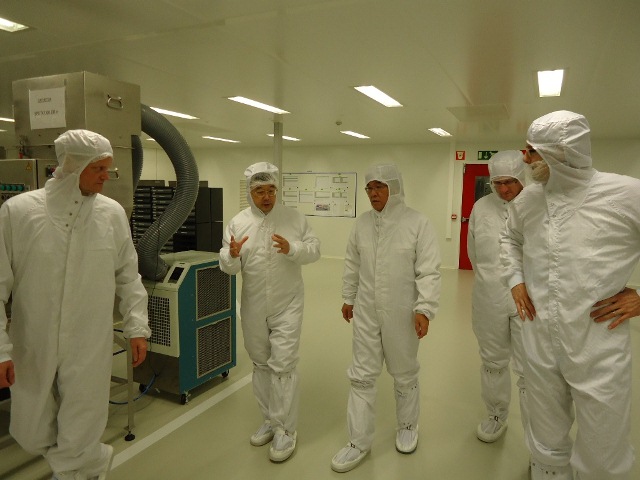 Last week I visited two Japanese companies. The first one was Terumo Europe NV, a manufacturer of medical equipment, whose factory is located in Haasrode on the outskirts of Leuven, 30km to the east of Brussels. This company started to operate here in 1971 when there was nothing but endless farmland, but now close to 700 small and large companies are integrated in the Industrial Park Haasrode. 1200 employees work at Terumo Europe among which 800 in Belgium. The main products are related to the cardiovascular field such as catheters, but Terumo Europe also manufactures and sells instruments such as syringes and blood collection tubes used in hospitals. Total sales in 2011 were 477 million euro, which makes it a medium-sized manufacturer in Europe where the medical equipment market totals 8-90 billion euro. Strict rules apply for the factory tour: we needed to wear a double layered sanitary suit and shoe covers and passed through a sterilizing air shower. This seems to be the “Japanese standard”. The world of medical equipment is rapidly progressing. After a long period of clinical tests, it takes time to get the approval from the authorities but the product’s life expectancy gets shorter to the extent. In the case of low-value-added products, it seems also difficult to continue the production in developed countries as the price competition with products from developing countries is severe. By the way, Terumo’s headquarters in Japan were established in 1921 by Dr. Shibasaburo Kitazato, one of the founding members, so the company has already a history of more than 90 years. The overseas sales ratio today is more than 50% and I think that it is indeed splendid that it is developing greatly as an international company.
Last week I visited two Japanese companies. The first one was Terumo Europe NV, a manufacturer of medical equipment, whose factory is located in Haasrode on the outskirts of Leuven, 30km to the east of Brussels. This company started to operate here in 1971 when there was nothing but endless farmland, but now close to 700 small and large companies are integrated in the Industrial Park Haasrode. 1200 employees work at Terumo Europe among which 800 in Belgium. The main products are related to the cardiovascular field such as catheters, but Terumo Europe also manufactures and sells instruments such as syringes and blood collection tubes used in hospitals. Total sales in 2011 were 477 million euro, which makes it a medium-sized manufacturer in Europe where the medical equipment market totals 8-90 billion euro. Strict rules apply for the factory tour: we needed to wear a double layered sanitary suit and shoe covers and passed through a sterilizing air shower. This seems to be the “Japanese standard”. The world of medical equipment is rapidly progressing. After a long period of clinical tests, it takes time to get the approval from the authorities but the product’s life expectancy gets shorter to the extent. In the case of low-value-added products, it seems also difficult to continue the production in developed countries as the price competition with products from developing countries is severe. By the way, Terumo’s headquarters in Japan were established in 1921 by Dr. Shibasaburo Kitazato, one of the founding members, so the company has already a history of more than 90 years. The overseas sales ratio today is more than 50% and I think that it is indeed splendid that it is developing greatly as an international company.
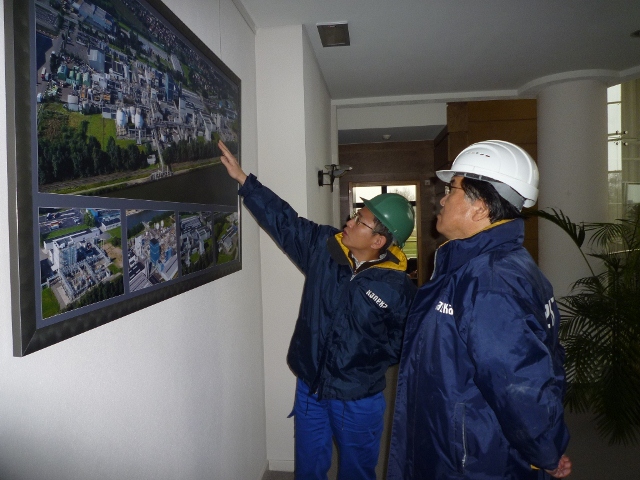 Three days ago I paid a visit to Kaneka Belgium, which is located in Oevel-Westerlo (24.000 inhabitants) 45km to the east of Antwerp (60km northeast of Brussels). The company was founded in 1970 (operations were started in 1974) and there are currently 320 employees working at Kaneka. Three petrochemical products are produced at this plant: Kane Ace, Eperan and MS Polymers. Total sales amounted to 273 million euros last year. Out of those three products, Kane Ace is the one that has been produced since the foundation of the company. It is used as a modifier for functional resin. For example, if you add a certain amount of Kane Ace during the manufacturing process of conventionally produced PET bottles in PVC, you obtain a strong bottle that does not break even when you drop it. There’s only a giant tank and hundreds of pipes in complex combinations in the plant. There’s not a person in sight. The employees work around the clock in three shifts in the control room, where their job consists of operating the computer screens showing the piping diagrams. It seems that petrochemical factories are like this everywhere, but I got the impression that these factories are quite different from factories that manufacture the usual industrial products. Three days ago I paid a visit to Kaneka Belgium, which is located in Oevel-Westerlo (24.000 inhabitants) 45km to the east of Antwerp (60km northeast of Brussels). The company was founded in 1970 (operations were started in 1974) and there are currently 320 employees working at Kaneka. Three petrochemical products are produced at this plant: Kane Ace, Eperan and MS Polymers. Total sales amounted to 273 million euros last year. Out of those three products, Kane Ace is the one that has been produced since the foundation of the company. It is used as a modifier for functional resin. For example, if you add a certain amount of Kane Ace during the manufacturing process of conventionally produced PET bottles in PVC, you obtain a strong bottle that does not break even when you drop it. There’s only a giant tank and hundreds of pipes in complex combinations in the plant. There’s not a person in sight. The employees work around the clock in three shifts in the control room, where their job consists of operating the computer screens showing the piping diagrams. It seems that petrochemical factories are like this everywhere, but I got the impression that these factories are quite different from factories that manufacture the usual industrial products.
< A Nobleman with the Title of Prince >
The other day I had dinner with a Belgian nobleman with the title of “Prince” and his spouse. There are 5 ranks within the nobility from Duke at the highest rank to Baron at the lowest rank. In case of Belgium, however, the noble title of “Prince” is ranking at the very top and 8 families are inheriting this title. It is hard to understand the difference between Prince and Duke, but if we look at it from the fact that the Belgian Crown Princes have inherited the title of “Duke of Brabant” from generation to generation and that families directly linked to the Belgian royal family have titles such as “Duke” and “Marquis”, I think that somehow the title of “Prince” is granted to noble families that have a connection with other countries such as Germany, Poland and the Netherlands. The people I had dinner with were originally German nobility that were given the title of “Marquis” in the Holy Roman Empire in the 17th century. After the aristocratic system was abolished, and maybe because their lands were near the Belgian border, the title of “Prince” was granted in Belgium at the beginning of the 20th century. What is interesting in the case of the Russian nobility is that the title of many Russian noblemen that had fled the country during the Russian Revolution has been recognized by Western European monarchies. Given that Belgium and the Netherlands are still monarchies today, a great number of noble families in both countries originated from Russia. Of course, in the modern era of the 21st century, having a noble title does not mean that one is entitled to particular privileges, but the implication seems to be that one gets to be recognized as being of noble blood. Come to think of it, the fact that the hereditary prince of Luxemburg married a Belgian countess last October became the talk of the town. When it comes to marriage, many weddings seem to happen between noble families.
< Nivelles et Ham-sur-Heure >
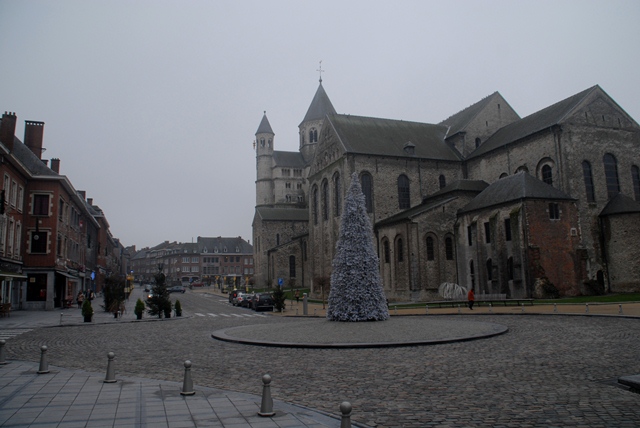 The Collegiate Church of Saint-Gertrude, which dates back to the 11th century, is located in the Central Square of the beautiful town of Nivelles (about 25.000 inhabitants), 40km to the south of Brussels. (See picture on the left: the current architecture was rebuilt after the war). This church was attached to the abbey (lost at the end of the 18th century) founded mid-7th century by Itta d’Aquitaine, wife of the Frankish King Pippin I. The church was named after Saint Gertrude who was the abbess and daughter of Pippin I. This Pippin I was the grandfather of the grandfather of Pippin III who founded the Carolingian dynasty, thus being the founder of the Carolingian house. By the way, the famous Charlemagne (crowned Emperor of the West by the Vatican in 800AD, the Emperor that built a Christian Europe) was Pippin III’s son. That is why the town of Nivelles is called the “cradle” of the Carolingian dynasty that laid the foundation of successive French dynasties.
The Collegiate Church of Saint-Gertrude, which dates back to the 11th century, is located in the Central Square of the beautiful town of Nivelles (about 25.000 inhabitants), 40km to the south of Brussels. (See picture on the left: the current architecture was rebuilt after the war). This church was attached to the abbey (lost at the end of the 18th century) founded mid-7th century by Itta d’Aquitaine, wife of the Frankish King Pippin I. The church was named after Saint Gertrude who was the abbess and daughter of Pippin I. This Pippin I was the grandfather of the grandfather of Pippin III who founded the Carolingian dynasty, thus being the founder of the Carolingian house. By the way, the famous Charlemagne (crowned Emperor of the West by the Vatican in 800AD, the Emperor that built a Christian Europe) was Pippin III’s son. That is why the town of Nivelles is called the “cradle” of the Carolingian dynasty that laid the foundation of successive French dynasties.
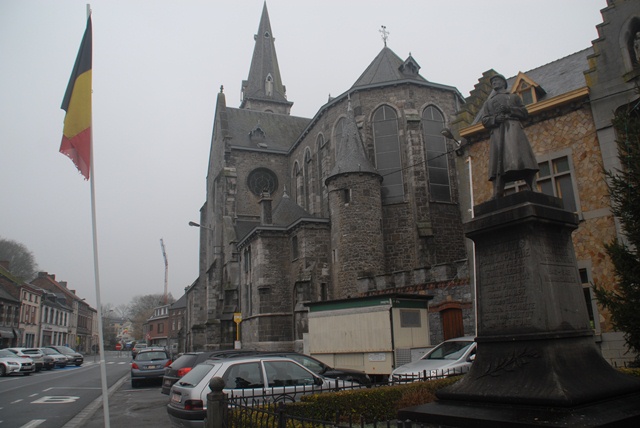 My visit to Nivelles the other day was linked to a young man (19 years old at the time) called Lambert Trouvez who studied more than 400 years ago in 1604 in this abbey, became a Jesuit missionary and was sent to Japan. He was born in 1585 in a small village called Ham-sur-Heure (current population 4.650 people), about 40km to the south of Nivelles. He arrived in Japan in 1612 at the age of 27 and did missionary work during the Anti-Christian Edicts published by the Tokugawa Shogunate, but was expelled after 2 years. However, the will of his mission was firm and he entered the country again in 1617. After doing clandestine missionary work for a couple of years, he was arrested in Nagasaki, sentenced to the stake in 1622 and became a martyr. Father Trouvez was 37 years old at the time. The same village name is still there in Ham-sur-Heure, the one where he was born. In the middle of vast farmland as far as the eye can see, several hundred houses surround the old church as to form a community (Picture on the right: view of the church surroundings). In fact, this village is situated 10km to the south of Charleroi, a city with 200.000 inhabitants. Ham-sur-Heure always remained the protagonist in the traditional “military marches” to which 40 neighbouring towns and villages participate every year. This event dates back to the 17th century while the storm of the Reformation was still raging and peasant soldiers, mobilized from neighbouring villages started to escort religious processions. One can only say that the life of the young Lambert Trouvez, born and raised in Ham-sur-Heure where religious fervour was exceptionally strong, who studied at the abbey located in Nivelles, the birthplace of the Carolingian dynasty, and who was finally sentenced to the stake in the foreign country Japan thus becoming a martyr, was amazing. Although he was the second Belgian to come to Japan, following Theodore Mantels (who was introduced in Ambassador’s Chat No. 5), he was the first Belgian to die in Japan. My visit to Nivelles the other day was linked to a young man (19 years old at the time) called Lambert Trouvez who studied more than 400 years ago in 1604 in this abbey, became a Jesuit missionary and was sent to Japan. He was born in 1585 in a small village called Ham-sur-Heure (current population 4.650 people), about 40km to the south of Nivelles. He arrived in Japan in 1612 at the age of 27 and did missionary work during the Anti-Christian Edicts published by the Tokugawa Shogunate, but was expelled after 2 years. However, the will of his mission was firm and he entered the country again in 1617. After doing clandestine missionary work for a couple of years, he was arrested in Nagasaki, sentenced to the stake in 1622 and became a martyr. Father Trouvez was 37 years old at the time. The same village name is still there in Ham-sur-Heure, the one where he was born. In the middle of vast farmland as far as the eye can see, several hundred houses surround the old church as to form a community (Picture on the right: view of the church surroundings). In fact, this village is situated 10km to the south of Charleroi, a city with 200.000 inhabitants. Ham-sur-Heure always remained the protagonist in the traditional “military marches” to which 40 neighbouring towns and villages participate every year. This event dates back to the 17th century while the storm of the Reformation was still raging and peasant soldiers, mobilized from neighbouring villages started to escort religious processions. One can only say that the life of the young Lambert Trouvez, born and raised in Ham-sur-Heure where religious fervour was exceptionally strong, who studied at the abbey located in Nivelles, the birthplace of the Carolingian dynasty, and who was finally sentenced to the stake in the foreign country Japan thus becoming a martyr, was amazing. Although he was the second Belgian to come to Japan, following Theodore Mantels (who was introduced in Ambassador’s Chat No. 5), he was the first Belgian to die in Japan.
|

